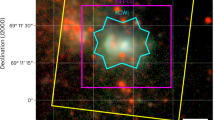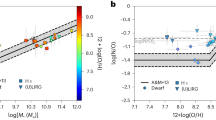Abstract
The discovery of metal-poor stars1,2 (where metal is any element more massive than helium) has enabled astronomers to probe the chemical enrichment history of the Milky Way3,4. More recently, element abundances in gas inside high-redshift galaxies has been probed through the absorption lines imprinted on the spectra of background quasars5,6,7,8, but these have typically yielded measurements of only a few elements. Furthermore, interpretation of these abundances is complicated by the fact that differential incorporation of metals into dust can produce an abundance pattern similar to that expected from nucleosynthesis by massive stars9. Here we report the observation of over 25 elements in a galaxy at redshift z = 2.626. With these data, we can examine nucleosynthetic processes independent of the uncertainty arising from depletion. We find that the galaxy was enriched mainly by massive stars (M > 15 solar masses) and propose that it is the progenitor of a massive elliptical galaxy. The detailed abundance patterns suggest that boron is produced through processes that act independently of metallicity, and may require alternative mechanisms for the nucleosynthesis of germanium.
This is a preview of subscription content, access via your institution
Access options
Subscribe to this journal
Receive 51 print issues and online access
$199.00 per year
only $3.90 per issue
Buy this article
- Purchase on Springer Link
- Instant access to full article PDF
Prices may be subject to local taxes which are calculated during checkout


Similar content being viewed by others
References
Chamberlain, J. W. & Aller, L. H. The atmospheres of A-type subdwarfs and 95 Leonis. Astrophys. J. 114, 52–72 (1951)
Helfer, H. L., Wallerstein, G. & Greenstein, J. L. Abundances in some population II K giants. Astrophys. J. 129, 700–719 (1959)
Wheeler, J. C., Sneden, C. & Truran, J. W. Jr Abundance ratios as a function of metallicity. Annu. Rev. Astron. Astrophys. 27, 279–349 (1989)
McWilliam, A., Preston, G. W., Sneden, C. & Searle, L. A spectroscopic analysis of 33 of the most metal-poor stars. I. Astron. J. 109, 2757–2799 (1995)
Lu, L., Sargent, W. L. W., Barlow, T. A., Churchill, C. W. & Vogt, S. Abundances at high redshifts: The chemical enrichment history of damped Lyα galaxies. Astrophys. J. Suppl. 107, 475–519 (1996)
Pettini, M., Ellison, S. L., Steidel, C. C., Shapely, A. L. & Bowden, D. V. Si and Mn abundances in damped Lyα; systems with low dust content. Astrophys. J. 532, 65–76 (2000)
Molaro, P. et al. UVES observations of QSO 0000-2620: Oxygen and zinc abundances in the damped Lyα galaxy at zabs = 3.3901. Astrophys. J. 541, 54–60 (2000)
Prochaska, J. X. & Wolfe, A. M. The UCSD HIRES/Keck I damped Lyα abundance database. II. The implications. Astrophys. J. 566, 68–92 (2002)
Vladilo, G. Chemical abundances of damped Lyα systems: A new method for estimating dust depletion effects. Astron. Astrophys. 391, 407–415 (2002)
Schramm, D. N. & Turner, M. S. Big-bang nucleosynthesis. Rev. Mod. Phys. 70, 303–318 (1998)
Fields, B. D. & Olive, K. A. The revival of galactic cosmic-ray nucleosynthesis? Astrophys. J. 516, 797–810 (1999)
Burbidge, E. M., Burbidge, G. R., Fowler, W. A. & Hoyle, F. Synthesis of the elements in stars. Rev. Mod. Phys. 29, 547–650 (1957)
Tinsley, B. M. Stellar lifetimes and abundance ratios in chemical evolution. Astrophys. J. 229, 1046–1056 (1979)
White, R. L. et al. The FIRST bright quasar survey II. 60 nights and 1200 spectra later. Astrophys. J. Suppl. 126, 133–207 (2000)
Wolfe, A. M., Turnshek, D. A., Smith, H. E. & Cohen, R. D. Damped Lyman-alpha absorption by disk galaxies with large redshifts. I—The Lick survey. Astrophys. J. Suppl. 61, 249–304 (1986)
Sheinis, A. I. et al. SI, a New Keck Observatory echellette spectrograph and imager. Proc. Astron. Soc. Pacif. 114, 851–865 (2002)
Prochaska, J. X., Gawiser, E., Wolfe, A. M., Cooke, J. & Gelino, D. The ESI/Keck II damped Lyα abundance database. Astrophys. J. Suppl. (submitted)
Vogt, S. S. et al. HIRES: the high-resolution echelle spectrometer on the Keck 10-m telescope. SPIE 2198, 362–375 (1994)
Savage, B. D. & Sembach, K. R. Interstellar abundances from absorption-line observations with the Hubble Space Telescope. Annu. Rev. Astron. Astrophys. 34, 279–330 (1996)
Jura, M. & York, D. G. Observations of interstellar chlorine and phosphorus. Astrophys. J. 219, 861–869 (1978)
Woosley, S. E. & Weaver, T. A. The evolution and explosion of massive stars. II. Explosive hydrodynamics and nucleosynthesis. Astrophys. J. Suppl. 101, 181–235 (1995)
Trager, S. C., Faber, S. M., Worthey, G. & González, J. J. The stellar population histories of local early-type galaxies. I. Population parameters. Astron. J. 119, 1645–1676 (2000)
Pettini, M. et al. The rest-frame optical spectra of Lyman break galaxies: Star formation, extinction, abundances, and kinematics. Astrophys. J. 554, 981–1000 (2001)
Pettini, M. et al. The ultraviolet spectrum of MS 1512-CB58: An insight into Lyman-break galaxies. Astrophys. J. 528, 96–107 (2000)
Saglia, R. P., Maraston, C., Thomas, D. & Bender, R. The puzzlingly small Ca II triplet absorption in elliptical galaxies. Astrophys. J. 579, L13–L16 (2002)
Woosley, S. E., Hartmann, D., Hoffman, R. D. & Haxton, W. The ν-process. Astrophys. J. 356, 272–301 (1990)
Cassé, M., Lehoucq, R. & Vangioni-Flam, E. Production and evolution of light elements in active star-forming regions. Nature 373, 318–321 (1995)
Busso, M., Gallino, R. & Wasserburg, G. J. Nucleosynthesis in asymptotic giant branch stars: relevance for Galactic enrichment and Solar System formation. Annu. Rev. Astron. Astrophys. 37, 239–309 (1999)
Hoffman, R. D., Woosley, S. E., Fuller, G. M. & Meyer, B. S. Production of the light p-process nuclei in neutrino-driven winds. Astrophys. J. 460, 478–488 (1996)
Wolfe, A. M., Prochaska, J. X. & Gawiser, E. CII* absorption in damped Lyα systems: A new window on the star formation history of the universe. Astrophys. J. (submitted)
Acknowledgements
These observations were made with the W.M. Keck Telescope. The Keck Observatory is a joint facility of the University of California, the California Institute of Technology, and NASA. J.C.H. acknowledges support from a NASA grant to UC San Diego.
Author information
Authors and Affiliations
Corresponding author
Ethics declarations
Competing interests
The authors declare that they have no competing financial interests.
Rights and permissions
About this article
Cite this article
Prochaska, J., Howk, J. & Wolfe, A. The elemental abundance pattern in a galaxy at z = 2.626. Nature 423, 57–59 (2003). https://doi.org/10.1038/nature01524
Received:
Accepted:
Issue Date:
DOI: https://doi.org/10.1038/nature01524
This article is cited by
-
Molecular hydrogen in absorption at high redshifts
Experimental Astronomy (2023)
-
Why Nature Chose Potassium
Journal of Molecular Evolution (2019)
-
De re metallica: the cosmic chemical evolution of galaxies
The Astronomy and Astrophysics Review (2019)
-
Heavy element synthesis in the oldest stars and the early Universe
Nature (2006)
-
The Need for Ultraviolet to Understand the Chemical Evolution of the Universe and Cosmology.
Astrophysics and Space Science (2006)
Comments
By submitting a comment you agree to abide by our Terms and Community Guidelines. If you find something abusive or that does not comply with our terms or guidelines please flag it as inappropriate.



